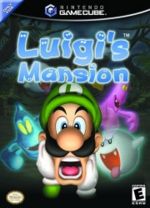Difference between revisions of "Luigi's Mansion"
(→Story) |
(→Legacy) |
||
| Line 29: | Line 29: | ||
This game is also notable for introducing E. Gadd, who has since made a few more appearances and is credited for several inventions in later ''Mario'' games. | This game is also notable for introducing E. Gadd, who has since made a few more appearances and is credited for several inventions in later ''Mario'' games. | ||
| + | |||
| + | Before the game's sequel was made, a minigame based on ''Luigi's Mansion'' was included in the 2002 [[Wii U]] title ''[[Nintendo Land]]'', known as Luigi's Ghost Mansion. | ||
==Ports/Remakes== | ==Ports/Remakes== | ||
Latest revision as of 07:56, 2 November 2018

| |
| Luigi's Mansion | |
| Developer | Nintendo |
| Publisher | Nintendo |
| System | Gamecube, 3DS |
| Release Date | Gamecube JP September 14, 2001 US November 18, 2001 EU May 3, 2002 AU May 17, 2002 3DS JP October 12, 2018 US October 12, 2018 PAL October 19, 2018 |
| Gallery | GH Gallery |
| Rating | ESRB: E |
Luigi's Mansion was a supernatural adventure game starring Luigi that was one of the launch titles for the Nintendo Gamecube. It marked a departure from Nintendo's launch titles up to that point, as it starred Luigi rather than Mario and was not a platforming adventure.
Story[edit]
Luigi finds out he won a mansion in a contest that he did not enter. Mario goes to check out the mansion and disappears, forcing Luigi to enter it alone. Within the mansion, Luigi quickly finds that it is infested with hostile ghosts. However, he then meets an eccentric old inventor, Professor E. Gadd, who provides him with ghost-catching technology in the form of the Poltergust 3000. With E. Gadd acting as his guide, Luigi sets off on a mission to capture the mansion's ghosts and save Mario.
Gameplay[edit]
This is Luigi's first official solo adventure (excluding the licensed title Mario is Missing), and its gameplay is different from other Mario games. Luigi explores the mansion room by room. Various enemy ghosts are found throughout the mansion, and they must be defeating by shining Luigi's flashlight onto them and sucking them into the vacuum-like apparatus known as the Poltergust 3000. While there are various generic ghosts found throughout the game, there are also twenty-three special ghosts that are known as Portrait Ghosts. They are mostly more human-like, harder to beat than normal ghosts and can only be captured by meeting certain conditions. Some of them act as boss characters. Boos also appear in the game, with fifty that have to be captured. Boos can escape into other rooms, so in some cases they must be pursued across the mansion.
Luigi is also equipped with a tool called the Game Boy Horror, which has a built-in map and can be used to scan objects and provide vital clues. Along the way, Luigi also collects money - not only coins, but dollar bills, pearls and jewels, that will come into play at the end of the game. Throughout the game, the player can also find three elemental medals that allow Luigi to respectively shoot fire, ice and water from the Poltergust.
Legacy[edit]
Although the game did not receive an official follow-up for over a decade, the game itself has become a vital part of Luigi's character, and his personality in this game has influenced his portrayals in most of his appearances since then. The actual mansion itself is the basis for many Mario Kart tracks, tennis courts, and locales for other spinoff games, including a stage in Super Smash Bros. Brawl.
This game is also notable for introducing E. Gadd, who has since made a few more appearances and is credited for several inventions in later Mario games.
Before the game's sequel was made, a minigame based on Luigi's Mansion was included in the 2002 Wii U title Nintendo Land, known as Luigi's Ghost Mansion.
Ports/Remakes[edit]
- In 2018, it was remade for the Nintendo 3DS. This version featured enhanced graphics, stereoscopic 3-D, two-player cooperative play (with the second player controlling a gooey doppelgänger of Luigi named Gooigi) and amiibo support. The 3DS's second screen was utilized for a map function, and the gameplay was also tweaked, including the option to use the Strobulb from Dark Moon. This version also featured a new Gallery mode, where the player could have rematches with the Portrait Ghosts that have been fought in the main mode.
Sequels[edit]
Over a decade after the original game was released, it finally received a sequel in the form of Luigi's Mansion: Dark Moon for the 3DS in 2013.
See Also[edit]
| Titles in the Luigi's Mansion subseries. |
|---|
| Luigi's Mansion - Dark Moon - Arcade - 3 |